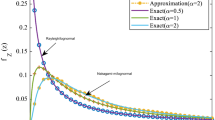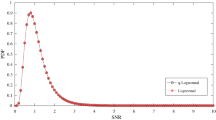Abstract
The fluctuating two-ray (FTR) channel is currently taken as a suitable small-scale fading model for fifth-generation millimeter-wave communications. This paper analyzes the performance in terms of the average bit error rate (ABER). The expressions of ABER of coherent and non-coherent modulation are evaluated using probability density function over FTR fading channels. Moreover, the behaviors of each modulation schemes are also studied based on the fading parameters. A comparison of the modulation schemes is also presented over FTR fading channels. The evaluated expressions are then verified with expected outcomes and Monte Carlo simulation.





Similar content being viewed by others
References
Rappaport, T. S., MacCartney, G. R., Samimi, M. K., & Sun, S. (2015). Wideband millimeter-wave propagation measurements and channel models for future wireless communication system design. IEEE Transactions on Communications, 63(9), 3029–3056.
Rangan, S., Rappaport, T. S., & Erkip, E. (2014). Millimeter wave cellular wireless networks: Potentials and challenges. arXiv preprint arXiv:1401.2560.
Rebato, M., Boccardi, F., Mezzavilla, M., Rangan, S., & Zorzi, M. (2017). Hybrid spectrum sharing in mmWave cellular networks. IEEE Transactions on Cognitive Communications and Networking, 3(2), 155–168.
Romero-Jerez, J. M., Lopez-Martinez, F. J., Paris, J. F., & Goldsmith, A. (2016). The fluctuating two-ray fading model for mmWave communications. In IEEE Globecom Workshops (GC Wkshps) (pp. 1–6). IEEE.
Samimi, M. K., MacCartney, G. R., Sun, S., & Rappaport, T. S. (2016). 28 GHz millimeter-wave ultrawideband small-scale fading models in wireless channels. In2016 IEEE 83rd vehicular technology conference (VTC Spring) (pp. 1-6). IEEE.
Zhang, J., Zeng, W., Li, X., Sun, Q., & Peppas, K. P. (2017). New results on the fluctuating two-ray model with arbitrary fading parameters and its applications. IEEE Transactions on Vehicular Technology, 67(3), 2766–2770.
Zeng, W., Zhang, J., Chen, S., Peppas, K. P., & Ai, B. (2018). Physical layer security over fluctuating two-ray fading channels. IEEE Transactions on Vehicular Technology, 67(9), 8949–8953.
Younis, A., Abuzgaia, N., Mesleh, R., & Haas, H. (2017). Quadrature spatial modulation for 5G outdoor millimeter-wave communications: Capacity analysis. IEEE Transactions on Wireless Communications, 16(5), 2882–2890.
Turgut, E., & Gursoy, M. C. (2017). Uplink performance analysis in D2D-enabled mmwave cellular networks. In IEEE 86th vehicular technology conference (VTC-Fall) (pp. 1–5). IEEE.
Peppas, K. P., Skrivanos, A., Xenos, E., Zhang, J., Kouretas, I., & Chronopoulos, S. (2018). Effective capacity of fluctuating two-ray channels with arbitrary fading parameters. In 2018 IEEE 19th international workshop on signal processing advances in wireless communications (SPAWC) (pp. 1–5). IEEE.
Zhao, H., Liu, Z., & Alouini, M. S. (2018). Different power adaption methods on fluctuating two-ray fading channels. IEEE Wireless Communications Letters, 8(2), 592–595.
Laishram, M. D., & Aheibam, D. S. (2020). Performance of dual-branch selection combining receiver over Fluctuating Two-Ray (FTR) fading channels for 5G mmWave communications. AEU-International Journal of Electronics and Communications, 117, 153093.
Olyaee, M., Eslami, M., & Haghighat, J. (2019). Performance of maximum ratio combining of fluctuating two-ray (FTR) mmWave channels for 5G and beyond communications. Transactions on Emerging Telecommunications Technologies, 30(10), e3601.
Romero-Jerez, J. M., Lopez-Martinez, F. J., Paris, J. F., & Goldsmith, A. J. (2017). The fluctuating two-ray fading model: Statistical characterization and performance analysis. IEEE Transactions on Wireless Communications, 16(7), 4420–4432.
Subadar, R., & Singh, A. D. (2013). Performance of SC receiver over TWDP fading channels. IEEE Wireless Communications Letters, 2(3), 267–270.
Goswami, S., & Singh, A. D. (2018). Performance of SC receiver over OWDP fading channels. In Advances in communication, devices and networking (pp. 399–408). Singapore: Springer.
Singh, A. D., & Goswami, S. (2015). Performance of digital modulations over TWDP fading channel. In 2015 International conference on electronic design, computer networks & automated verification (EDCAV) (pp. 135–138). IEEE.
Subadar, R., & Singh, A. D. (2014). Performance of M-MRC receivers over TWDP fading channels. AEU-International Journal of Electronics and Communications, 68(6), 569–572.
Gradshteyn, I. S., & Ryzhik, I. M. (2014). Table of integrals, series, and products. Cambridge: Academic Press.
Srivastava, H. M., & Karlsson, P. W. (1985). Multiple Gaussian hypergeometric series. Amsterdam: Ellis Horwood.
Author information
Authors and Affiliations
Corresponding author
Additional information
Publisher's Note
Springer Nature remains neutral with regard to jurisdictional claims in published maps and institutional affiliations.
Rights and permissions
About this article
Cite this article
Devi, L.M., Singh, A.D. Performance Analysis in Terms of Bit Error Rate Over Fluctuating Two-Ray (FTR) Fading Channels. Wireless Pers Commun 118, 889–899 (2021). https://doi.org/10.1007/s11277-020-08049-9
Accepted:
Published:
Issue Date:
DOI: https://doi.org/10.1007/s11277-020-08049-9




